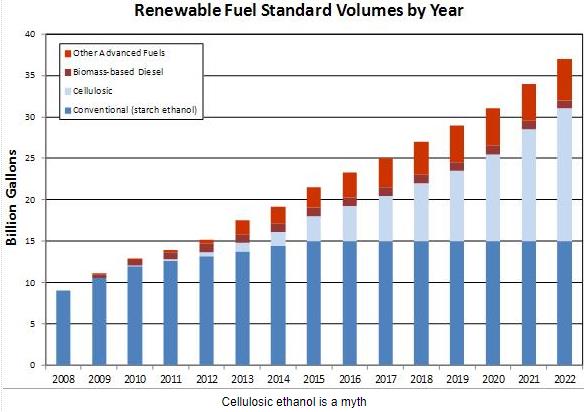 Tom Philpott writing in the January 19th edition of The New Republic documented the fallacy of corn-based ethanol as a sustainable source of energy. During the energy crisis of the 1970’s, the concept of using corn as a substrate to produce ethanol was initiated. The industry grew slowly given that ethanol had to compete with petroleum products on a level playing field. In 2007, the Renewable Fuel Standard was developed essentially to make the U.S. independent of oil supplied by ‘unfriendly’ nations. According to Philpott, in 2004 eleven percent of corn was converted to ethanol and byproducts. This proportion has increased to a projection of 32 percent of the 2024 crop.
Tom Philpott writing in the January 19th edition of The New Republic documented the fallacy of corn-based ethanol as a sustainable source of energy. During the energy crisis of the 1970’s, the concept of using corn as a substrate to produce ethanol was initiated. The industry grew slowly given that ethanol had to compete with petroleum products on a level playing field. In 2007, the Renewable Fuel Standard was developed essentially to make the U.S. independent of oil supplied by ‘unfriendly’ nations. According to Philpott, in 2004 eleven percent of corn was converted to ethanol and byproducts. This proportion has increased to a projection of 32 percent of the 2024 crop.
There is no issue that unites both Republican and Democratic legislators from corn-producing states than preserving and extending the Renewable Fuel Standard. Without the mandated diversion of approximately 5 billion bushels of corn to ethanol, the price for the commodity would be far lower, possibly under the cost of production and accordingly reducing output in addition to maintaining the artificially high value of cropland.
 Every bushel of fermented corn produces one-third each of ethanol, dried distillers solubles and carbon dioxide, a greenhouse gas. At this time, carbon dioxide should be sequestered on site subject to suitability of the ground on which the plant is located. Plans to install a web of pipelines to transport carbon dioxide from plants to a disposal site in North Dakota have been scuttled by the very farmers who benefit from ethanol production but reject the environmental effects of their crop.
Every bushel of fermented corn produces one-third each of ethanol, dried distillers solubles and carbon dioxide, a greenhouse gas. At this time, carbon dioxide should be sequestered on site subject to suitability of the ground on which the plant is located. Plans to install a web of pipelines to transport carbon dioxide from plants to a disposal site in North Dakota have been scuttled by the very farmers who benefit from ethanol production but reject the environmental effects of their crop.
Although ethanol is quoted on the Chicago Mercantile Exchange, it does not trade due to indifference to the commodity. Exports represent less than ten percent of production amounting to approximately one million barrels per day. Attempts to increase demand by marketing higher gasoline blends exceeding ten percent would appear to have languished due to the high cost of installing multi-blend fuel pumps at filling stations and the inability of older vehicles to run on more than a ten percent ethanol content.
The ethanol industry is justifiably concerned over the rise in EV adoption although sales of these vehicles have leveled in the U.S. As more charging points are installed in both homes and for public use in accordance with current federal climate-mitigation policy, the demand for ethanol will shrink.
Claims that ethanol is “clean burning” are fallacious. Even with E-15 blend, 85 percent of fuel used to power a vehicle comprises gasoline. Studies that take into account all of the energy inputs to grow and harvest corn and convert the product to ethanol suggest that there is no net energy saving but that carbon dioxide produced is detrimental to the environment if vented. The quantity of water required for cooling bioreactors is immense, occassionaly depleting aquifers in the vicinity of plants.
 |
According to the 2023 Iowa Climate Statement accepted by 200 scientists in over 30 colleges and universities, a one-acre solar farm produces as much energy as 100 acres of corn-based ethanol. The problem of large arrays displacing corn production relates to deficiencies in the grid. If energy from solar arrays is available to charge EV’s energy utilization is highly efficient since electric vehicles convert over 90 percent of energy to motion compared to internal combustion engines with an efficiency of less than 25 percent.
Government policy on ethanol that may have been justifiable at the turn of the century is now a liability. The RFS represents an indirect tax on all who travel and eat. In millennia to come, archeologists will wonder at the inhabitants of the Midwest who apparently worshiped large tanks much as the Druids erect Stonehenge and the ancient Egyptians erected their pyramids and obelisks.
Unfortunately, ethanol has acquired a momentum that is now impossible to restrain notwithstanding distortion of the agro-economy. Ethanol is maintained by the mendacity of politicians supported by the ethanol industry and their constituents at the cost of all consumers in common with livestock and poultry producers.